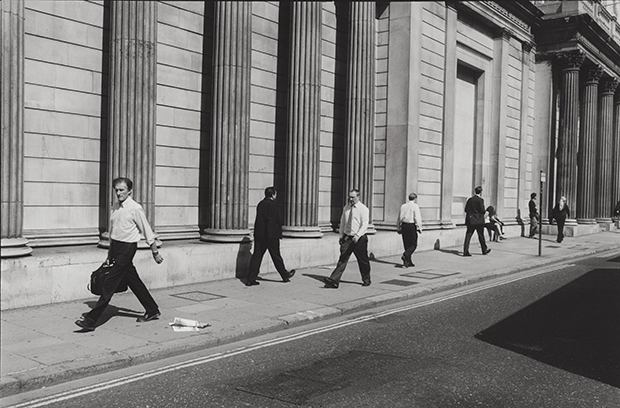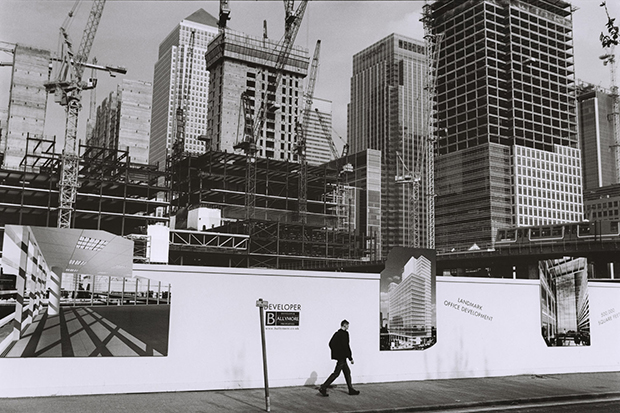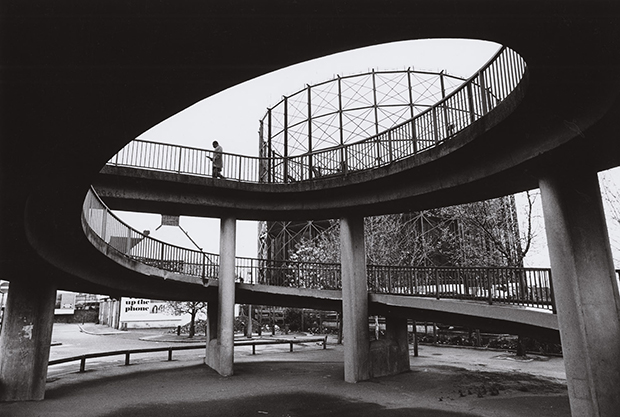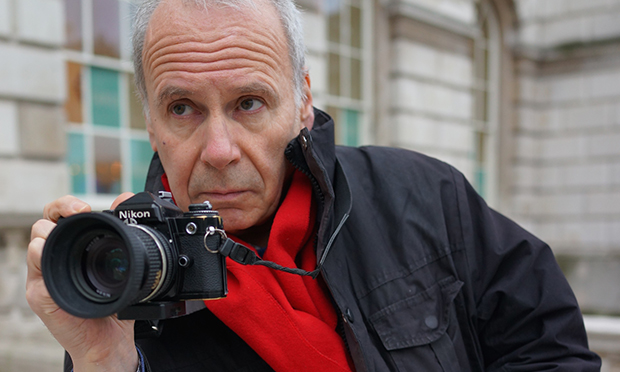Lost in the City: photographs of the Square Mile inject life into icy scenes

Places to go: busy office workers make strides. Photograph: Nicholas Sack
Photographer Nicholas Sack’s Lost in the City is a collection of images exploring London’s financial district.
The series positions the people of this strange world – generally office workers, occasionally stray tourists – against the imposing architecture, creating a sub-reality that on first impression is alien and oppressive, but captivating, nonetheless.
When I reviewed the book back in January for the East End Review, I described the images as “cold and clinical” and commented on how the patterns and symmetries in the buildings mirror the repetitive routines of nine-to-five commerce.
I was impressed by the geometry, the meticulous and rigid order that Sack arranges within the viewfinder. But most of all, I found the volume detached, harsh and haunting.
But on meeting the photographer and discussing his work, I quickly realise that my initial perceptions only skimmed the surface of what is a complex and multilayered project.
Sack has been photographing the City of London for 30 years and there’s more to this latest assemblage, taken from the last decade, than first meets the eye.

Under construction: building site in financial district. Photograph: Nicholas Sack
Drinking beer in the Crosse Keys on Gracechurch Street, a striking old banking hall built on the site of an ancient coaching inn and since taken over by JD Wetherspoon, Sack runs me through a selection of his black and white prints; some are from the book and others are not, but the subject remains the same.
“I find some of these human gestures, these angles, the way people sit and stand, very interesting… there’s a sort of vulnerability or unwitting disclosure,” he says, describing what he likes most about a shot of three people eating lunch on a concrete bench.
“I’m not looking for car crashes or great dramatic events. It’s really just the tiniest gesture that can look most interesting.”
He points his pen at one lady’s foot, which has slipped out from her shoe and is caught in a surprisingly elegant pose. This tiny detail, which I miss at first but is clearly the main focus for Sack, warms the image significantly.
Whether it is through discomfort or ease, the subtlety makes the composition less symmetrical, more familiar and ultimately more human.
Many of the pictures in Lost in the City contain such minutiae: there’s a pointed finger, an open purse, a splayed hand resting against bare shin, for example – all of which show Sack to be a sympathetic photographer.
Amidst the stark, difficult landscape, he finds spontaneous moments of simple beauty that inject life into the icy scenes.
Of an image of five men in crisp white shirts marching past the Bank of England, he explains: “This is a feature of the camera catching things quickly; while these men are clearly affluent, working in high finance, they also reveal a physical delicacy.
“Those heels that are on the floor with the toes pointing upwards strike a balletic pose that doesn’t quite fit with the image of the thrusting alpha male.”
All of a sudden, the men are no longer marching; they are breezing through the City.
This new perception adds an ethereal quality that intensifies the juxtaposition between the looming buildings and the figures below. Whilst the contrast could suggest a political stance on Sack’s part – criticising the capitalist regime – he insists that despite his staunchly socialist upbringing this is not the case.
“I’m looking at things purely from a visual point of view,” he says. “My feelings about what these people are doing are quite separate – they really don’t intrude at all. In fact, I like to get to the stage where the real world becomes abstract – I’m a formalist in that way.
“People assume that I think the City and Canary Wharf are sterile and repetitive and monotonous, which is not true – that’s not the way I feel. I find the regularity and uniformity rather exciting.”

Harsh beauty: man on walkway in East London. Photograph: Nicholas Sack
Sack’s artistic education was diverse, but in its way perfect for his chosen topic. Born in Sussex and raised predominantly in Greenwich, he studied urban planning at Aston University, before returning to London to do a postgraduate degree in journalism.
At the same time as working an office job, he played the drums in rock bands, which he says contributed to his appreciation of rhythm and structure.
“I think that being a drummer relates to some of this love of order. There’s a metronomic steadiness to things that I appreciate visually, so there may well be a connection.”
He didn’t pick up a camera, however, until his mid-20s, when a fellow student introduced him to the darkroom.
He was instantly hooked. “I ended up photographing freelance for 30 years, mostly for business magazines and corporate clients. So it wasn’t pre-planned and I’ve had no formal training, which is to my detriment in many ways, because I’ve picked up bad habits and I’ve had to work pretty much intuitively.”
Though he’s photographed abroad and on regular long walks in the countryside, Sack hasn’t strayed too far from the capital.
As such, he’s become something of an authority on the territory; he’s also been influenced over the last decade by the roving methods of his literary hero, Iain Sinclair, who provided an insightful introduction to Lost in the City.
“The fact that I’ve lived in London all my life and I’ve done it on foot, because I’ve never had a car, means that I know all these cut throughs and alleys… I love that. It’s as though I’m a tourist but with privileged information, an inside knowledge.”

Nicholas Sack. Photograph: Timothy Cooke
Despite the technological advances of recent years, Sack has remained dedicated to film photography. He shoots in black and white, he doesn’t use a tripod and he refuses to crop any of his images, relying entirely on his skill to perfect the frame in the field. He describes himself as a dinosaur and explains that he loves the craft process.
“I enjoy the interregnum, if you like, the hiatus – the time between shooting the picture and knowing what’s there on the film. I enjoy the period of not knowing. It’s my stand against instant gratification. It might be months before I see what’s on the film, and then it may be years before I print what’s there. I enjoy that – it’s part of the mystery and beauty of photography.”
There’s a level of intensity to Sack and his approach that as we chat becomes more apparent. He seems to aspire to a state of heightened awareness, which, he says, allows him to almost anticipate what’s coming around the corner. Moreover, he doesn’t own a TV, is a serious collector of books and photographs, and he prints his images in month-long stints. There’s a discipline here, an august devotion that serves him well.
But it’s his enthusiasm for the medium that leaves the strongest impression: “This is what’s special to photography. In painting you could make all this up, couldn’t you, through your imagination. For me, the glory is in seeing it, actually being there and witnessing real life. And often not realising the significance until later, until I see the pictures in the darkroom.”
Lost in the City is published by Hoxton Mini Press. ISBN: 9781910566039. RRP: £12.95
